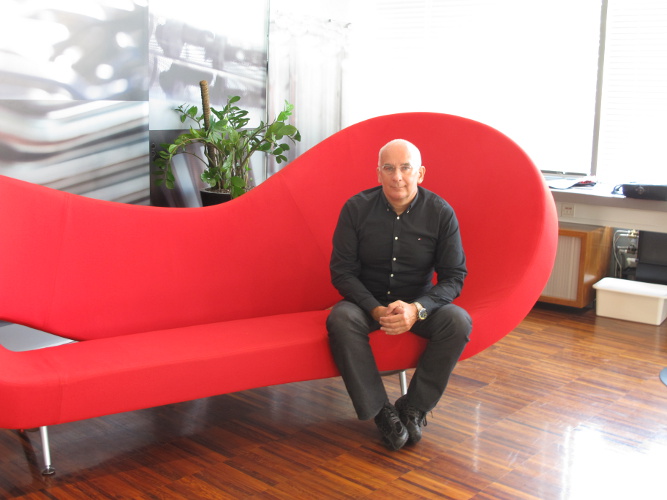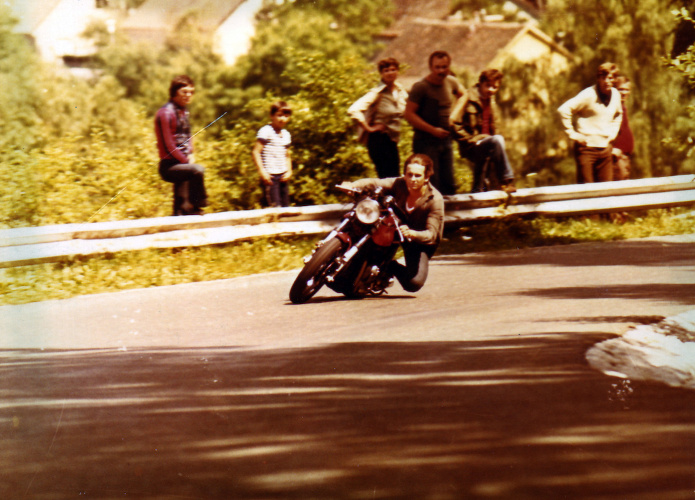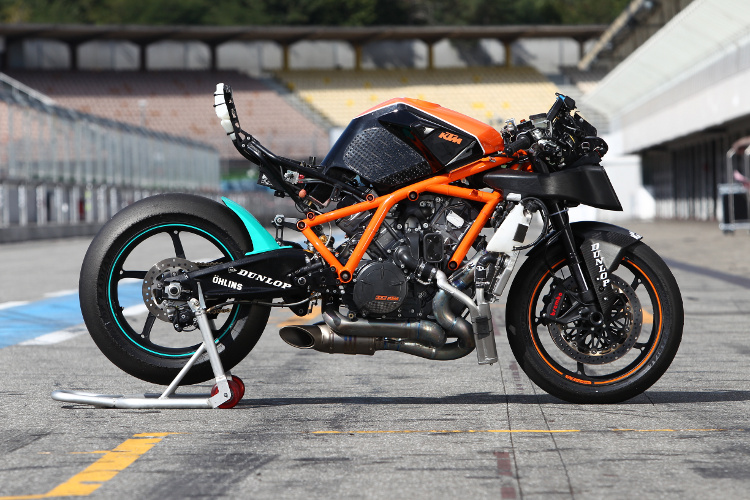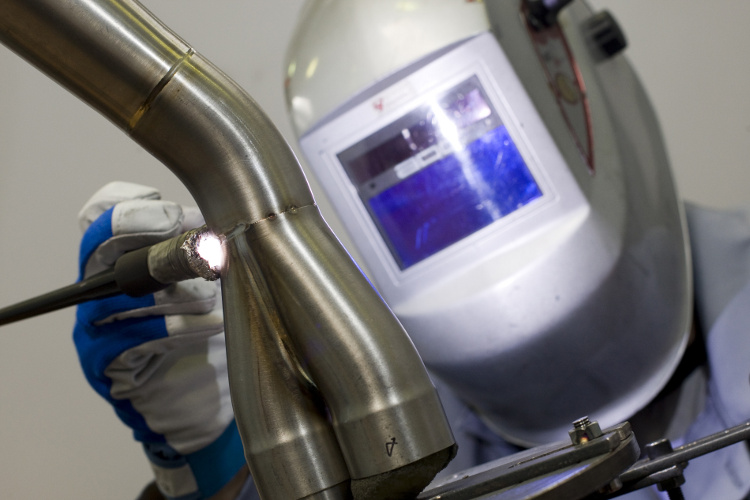AKRAPOVIČ – INTERVIEW
It is impossible to visit the Akrapovič factory and not be impressed by the modern architecture. The buildings on the outskirts of Ivancna Gorica glimmer mysteriously in the Slovenian sun. Anyone visiting the factory for the first time might easily mistake it for a NASA site (there are no company signs anywhere to be seen). When I mention this to Igor Akrapovič at the start of my visit, he passes on the complement with a wry smile: “That’s not down to me. My wife Slavojka is responsible, she’s an architect.”
Igor Akrapovič‘s office is airy and spacious, with glass and metal furnishings and a wooden floor. There are two desks, two conference tables, and an imposing, eye-catching red sofa. Against one wall stands the VTR1000 SP-2 on which Colin Edwards contested the 2000 Superbike World Championship season, winning the first world title for the Slovenian exhaust specialist. The man of the house is known to like dark clothes. True to form, Igor is wearing a black shirt, black trousers and black trainers for our meeting. Although he no doubt has a million things to do, he takes his time, appears relaxed and composed, and makes us feel more than welcome.
The famous exhaust manufacturer’s roots lie in motorsports. And Igor recalls how it all started: “I raced motorcycles myself for more than ten years. I could have joined my father’s company at some point, which produced plastic items, but I was fully focused on my racing career. I admired the big stars and wanted to be part of the scene. I always took care of the technical side of the machines myself. I started out with a tuning shop, reconditioning and preparing engines for other riders. That was back in 1990. My work revolved around valves, cylinder heads, pistons and camshafts. I specialised in Kawasaki and the Honda RC30, then Ducatis as well. I soon realised that the exhaust systems back then weren’t ideal, so I decided to build my own. After five or six months, I bought my first pipe bending machine. The first test bench followed shortly after. From then on, it was all about rolling up my sleeves and making progress. Trying different things, tinkering, developing, gaining experience.”
The exhaust systems, which were initially sold under the brand name “Scorpion”, were very popular with sport riders and had the same traits that Akrapovič systems are famous for today: they were light, performance-boosting, cleverly arranged and affectionately crafted. Word of these qualities soon got around, and more and more motorcycle racers and teams became customers.
Igor remembers the breakthrough on the international motorsports scene: “First, Kawasaki Germany tried out my exhaust system with Jochen Schmidt at the Pro Superbike Championship at the end of 1993. They were very happy with it. In 1994, Schmidt also made guest starts at the Superbike World Championship, during which his ZXR 750 made it round the Hockenheim circuit faster than the official factory bikes. Keen to find out why, the Japanese requested some exhaust test samples, which they rigorously put through their paces at the factory. They must have been impressed by the results. When Harald Eckl took over as manager of “Team Green” at the World Championship and wanted to use our exhaust, the Japanese agreed. It all happened very quickly from there. Less than two years later, all Japanese manufacturers were using our systems at the Superbike World Championship. This was, of course, a great help in boosting awareness of our exhaust brand.”
Something unusual then happened in 1997: the name was changed from Scorpion to Akrapovič, due to a trademark dispute with the car manufacturer Ford, which manufactured the “Scorpio” at the time. “We were a company with 16 employees,” remembers Igor. “But we really could have done with 16 lawyers to take on a global corporation in court. But it never got that far. As all decent alternatives were also trademark protected, we decided to use my name and see how things panned out. Akrapovič sounded independent and a bit exotic, so we didn’t think it would cause any problems. In fact, it was quickly accepted as a brand name.”
Meanwhile, Akrapovič is a globally established company with 700 employees, producing almost 100,000 exhaust systems a year – for one-, two-, three- and four-cylinder engines, for racing and series bikes. The company now also produces systems for cars as well as for custom bikes and scooters above 125cc. Systems for four-cylinder engines make up a large proportion of production, but KTM also offers many twin-cylinders. This raises the question as to what is more challenging for an exhaust specialist in terms of design: systems for twin-cylinder or four-cylinder engines?
“Twin-cylinders are more difficult, because the space on a motorcycle is more restricted and cramped,” says Igor. “Four cylinders also allow for more configurations, i.e. 4-in-1 or 4-in-2. In the case of a twin-cylinder, it’s not actually possible to build an optimum exhaust if it has to be fitted beneath the engine, like on a Panigale. One can only try to make the most of the circumstances. In terms of performance, it remains a major challenge.”
Igor Akrapovič continues: “For Colin Edwards’ VTR1000 Honda, we developed a total of 54 different exhaust systems over a period of three years. Honda improved the motorcycle continuously. They really pushed themselves – and us, too! We did a lot of development work in 1999, 2000 and 2001. It was incredibly hard work and expensive, but we learned a great deal. As a result, we’re now also very comfortable with twin-cylinders. Most of our experience is with inline fours, of course, but we’re also familiar with Big Bang engines, which require slightly more complex solutions. But it’s fair to say that systems for four-cylinders are easier to implement than for twins.”
Another factor to consider is that engines are being continuously improved, which means exhaust systems must develop accordingly. This also involves taking into account the requirements of the riders. The teams sometimes use different types of exhaust, because certain riders feel more comfortable with them. One may prefer more torque, while another would rather have top performance. “Like the performance curve, these things can be influenced by the exhaust,” adds Igor Akrapovič. “At least our experience allows us to do so. We also have to consider things that can’t be determined on the test bench. Such as response behaviour, which isn’t visible in the test logs. Riders sometimes complain about it. Even though the performance curve looked perfect, they aren’t happy when twisting the throttle. No connection to the back wheel, no good feeling. And it’s usually the developer’s fault. Other riders feel that this system is easier to control and has better throttle response along the same power curve. Thus, it’s purely a matter of feeling. That’s why extremely good staff are needed for development. People with lots of experience who are very dedicated to their work.”
The KTM and Akrapovič partnership began in 1999 with Supermoto and has since extended across all disciplines, on asphalt as well as offroad. So, were any of the KTM exhausts tricky to develop? Igor Akrapovič doesn’t have to think long: “The racing system for the RC 8 Superbike was complicated, because an underfloor arrangement also makes cooling more difficult. But we eventually managed it by using new materials. The simple fact is: each engine has its own characteristics that need to be taken into consideration.”
In the case of KTM’s Moto3 racer, the single-pipe exhaust system was replaced with a design featuring two megaphone silencers after the first season. Why? “Because the performance curve could thereby be improved. Single-cylinder engines are extremely responsive. It’s actually easier to refine them in GP sport, as the loudness is not such an issue. But it’s completely different in offroad sport, where two or three decibels pose an enormous challenge, more in terms of torque and response behaviour than top performance. That is the biggest problem: achieving similarly good torque values despite lower noise levels.”
The company has been developing exhaust systems in Slovenia for more than two decades, both for street riders and for motorcycle racers and racing teams. The company has a wealth of experience in using the material titanium. What are the biggest differences? Igor Akrapovič: “The development processes are similar, only the objectives are different. Exhaust systems for the road have to be homologated and meet all sound and emission requirements. Of course, we always strive for maximum performance. The sound must be pleasant, even if it has to be quieter. Appearance is also important, of course.”
“Certain noise limits have to be adhered to in Superbike sport, unlike in GP sport. Nevertheless, they must always offer optimum performance and be as light as possible. The objectives are therefore different here as well. We always try to offer our customers the best technically feasible solution, not just in terms of design and materials but workmanship and quality in general. That’s why there are numerous commercial racing systems that are exactly the same as those used by famous racing teams.”
Alongside the purely technical components, what sets Akrapovič apart is that it nurtures productive collaborations with all important motorcycle manufacturers and brands, both in Europe and Japan. How it that possible? “By working in an extremely careful and professional manner,” explains the Slovenian entrepreneur.“Luckily, we’ve managed this very well for many years. We draw strict boundaries and don’t share our partners’ secrets among them. They know they can trust us. Thanks to our expertise, we can help them exploit certain performance advantages, but that’s all. They have to do the rest themselves.”
Does the Exhaust God ride a motorcycle himself? “Yes, I’ve had a Diavel for three years. But because of the relocation of production to Crnomelj, which has been going on for more than half a year, I’ve hardly had time to ride.” Igor mentions the low seat height as a particular advantage, as he injured his knee in the snow a few years ago. “It’s Sod’s law,” he says, shaking his head in disbelief. “After eleven years of racing a motorcycle without a serious accident, I get injured playing in the snow with my four-year-old daughter! I damaged my ligaments and meniscus, which hampered me for a long time. I eventually had an operation and, luckily, I’m ok again now.”
Igor’s office is on the first floor of the hall that houses both the prototype workshop and race department. The test bench for the racers is directly below it, virtually beneath his feet, which, surprisingly, doesn’t bother him at all. “The noise isn’t a problem,” he grins. “In fact, quite the opposite. If I didn’t like it, I wouldn’t be in this business. It only gets really loud when a MotoGP bike is running on the test bench. But it’s only really an issue if a meeting is taking place at the same time.”
Igor Akrapovič: “The noise isn’t a problem,” he grins. “In fact, quite the opposite. If I didn’t like it, I wouldn’t be in this business. It only gets really loud when a MotoGP bike is running on the test bench. But it’s only really an issue if a meeting is taking place at the same time.”
The race department has been managed by Slavko Alojz Trstenjak for years. He is one of Igor Akrapovič’s closest colleagues. As a big offroad fan, he has made a significant contribution to the collaboration with KTM, which started in 1999 with Supermoto and now covers all areas (road racing, offroad and rally sport).“Development never actually stops,” ads Igor with an impish grin. “When the test bench is running beneath me, often all day long, I occasionally like to go down, because I’m interested in what’s currently going on. New developments are always exciting. Besides, when running such a company, there are bigger problems than having to listen to the sound of a race bike, even if it is a MotoGP bike.”
The company Akrapovič will celebrate its 25th anniversary next year. Sales figures have grown continuously year on year. Millions is spent on continuous development and innovation. The hexagonal silencers revolutionised exhaust design several years ago. A new six-sided design has since been introduced at theINTERMOT exhibition. With its bent shape, it can achieve better flow rates with the same pipe diameter. New markets will be tapped into and new products are envisaged, including in other areas. The range of products for cars is being expanded, along with production capacities – the future looks bright.
“I am confident that we will continue to grow in the motorcycle business,” says Igor Akrapovič. To achieve this, we want to continue working with the best teams in MotoGP, Superbike and offroad sport. It allows us to learn, try out different technologies and gain experience. Motorsport expertise is always a positive thing and useful for series production.”
Like KTM, it is impossible to imagine the world of racing without the company Akrapovič.
Igor Akrapovič: “Racing has always been important and a real passion of mine. Before the company was founded and especially afterwards. Some competitors pursue other strategies and throw money at advertising or sponsorship to get the message across. But that’s not how it works. We endeavour to build exhaust systems that are optimum in every respect, use them in motor racing and apply our knowledge to series systems. Victories and success are acknowledged, giving the brand a certain prestige and stimulating our business. Without racing, Akrapovič would certainly not be what it is today.”





